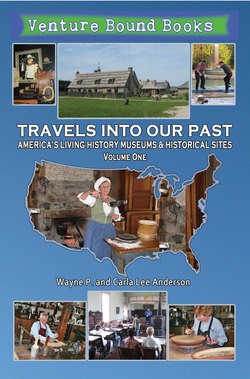Читать книгу Travels Into Our Past: America's Living History Museums & Historical Sites - Wayne P. Anderson - Страница 14
8. American Village Montevallo, Alabama
ОглавлениеAt American Village near Montevallo, Alabama, we ran into the unexpected. Our guidebook suggested it would give us an opportunity to experience what times were like as our country grew.
However, when we got there, we found the public tour had been canceled because of an influx of fifth-graders—five buses with 50 to a bus. We were given permission to take the tour with one of the groups of pupils.
We started our walk through history with the “pilgrimage to the new world.” As the students entered the meeting hall, each was given a “passport through the centuries” with a page of questions about each experience they would be having and a small card assigning each of them a role to help increase their sense of being back in a historical time.
After we seated ourselves on benches, a man and a woman in 17th century costumes told us stories and asked questions. He indicated we had been in Holland for the past three years and that some of us had just been given permission to sail to America on the Mayflower. He described the hazards we were about to undergo. The cards the students had been given indicated which of them were to go, and those students stood up, answered questions and told us what their fears and concerns were.
In our next stop in the walk, we found ourselves learning how to fire muskets with the Rhode Island Regiment during the middle of the Revolutionary War. A soldier explained how inaccurate the weapons were, and that was why soldiers fired as a group at another group; soldiers could count on someone getting hit if they fired enough bullets. We were given a lesson in marching and mimed loading, shooting and charging with fixed bayonets.
Next, we became spies. We were taken to an encampment where a Capt. Hamilton told us about a double agent who had been planted in a British camp pretending he had secret information from George Washington’s army. So we trooped over to the British camp, where Gen. Charles Cornwallis ranted on about how dumb the Americans were and how much they needed the leadership of a king and his people if they were to succeed in this country. We reported back to Hamilton to tell him Cornwallis had fallen for the false information.
Captain Hamilton tells us about thedouble agent planted in the British camp.
Another stop was at a large colonial church meeting, which resulted in the Declaration of Sentiments at Seneca Falls. A costumed woman explained the lack of rights for women and distributed handouts.
The children especially enjoyed Harriet Tubman’s story “Follow the Drinking Gourd.” The re-enactor told them about her history and how she was working to get slaves to freedom through the Underground Railroad. She said we would act as slaves, and she would help us escape. When we met in a darkened room, she taught us a song that would help us find directions. The drinking gourd is the big dipper and the North Star. We then escaped and were stopped by a white man looking for escaped slaves. He allowed us to go on but shot his black-powder revolver in the air to make us move faster. After all this adventure, the children were ready for the lunch provided.
The educational programs have been in operation since 1995. We appreciated this method of educating children about history. We suspect the regularly scheduled tour might not be quite as much fun as this one, but we especially enjoy watching kids enthusiastically learn.
Gen. Charles Cornwallis ranting on about
how dumb the Americans are
